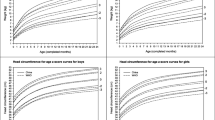Abstract
Longitudinal growth data for infants in Qatar were compared to growth standards published by the CDC and WHO. 300 randomly selected full-term normal infants (150 males, 150 females) in Qatar were followed-up and weight and length were sequentially recorded at 2 months, 4 months, 6 months, 12 months and 18 months age. The mean length for age of girls was higher than those published by the CDC and WHO at 12 and 18 months of age. Using the CDC standard for weight for length detected more wasted infants (9.0% and 6.5%) compared to using WHO standards (6.27% and 6.0%) for males and females, respectively. When WHO and CDC standards are compared, more infants were identified as overweight when the former were used. The WHO standards are preferable because they are based on a leaner breastfed reference and because overweight is likely to be a greater problem in Qatar in the future.
Similar content being viewed by others
References
Department of Economic and Social Affairs Population Division. (2009). World Population Prospects, 2008. United Nations.
De Onis M, Garza C, Onyango AW, Borghi E. Comparison of the WHO Child Growth Standards and the CDC 2000 Growth Charts. J Nutr. 2007;137;144–8.
Kuczmarski RJ, Ogden CL, Grummer-Strawn LM, Flegal KM, Guo SS, Wei R, et al. CDC growth charts: United States. Advance data from vital and health statistics, no. 314. Hyattsville (MD): National Center for Health Statistics; 2000.
Kuczmarski RJ, Ogden CL, Guo SS, Grummer-Strawn LM, Flegal KM, Mei Z, et al. 2000 CDC growth charts for the United States: methods and development. Vital Health Stat 11. 2002;246:1–190.
Annonymous. 2000 CDC Growth Charts for the United States: Methods and Development. Series Report 11, No. 246. 201 pp.
Babson SG, Benda GI: Growth graphs for the clinical assessment of infants of varying gestational age. J Pediatr 1976; 89: 814–820.
Catrine KF. Anthropometric assessment. In: Groh-Wargo S, Thompson M, Hovasi-Cox J. Eds. Nutritional Care for High Risk Newborns, 3rd Edition: Chicago, Precept Press 2000.
Yang H, de Onis M. Algorithms for converting estimates of child malnutrition based on the NCHS reference into estimates based on the WHO Child Growth Standards. BMC Pediatrics. 2008;8:19.
de Onis M, Garza C, Adelheid W. Onyango, Borgh E. Comparison of the WHO Child Growth Standards and the CDC 2000 Growth Charts. J Nutr. 2007;137:144–148.
von Kries R, Koletzko B, Sauerwald T, von Mutius E, Barnert D, Grunert V, et al. Breast feeding and obesity: cross sectional study. BMJ. 1999;319:147–150.
Khadilkar V, Khadilkar AV, Chiplonkar SA. Growth performance of affluent Indian preschool children: A comparison with the new WHO growth standard. Indian Pediatr. 2010;48:869–872.
Curhan GC, Chertow GM, Willlett WC, Spiegelman D, Colditz GA, Manson JE, et al. Birth weight and adult hypertension and obesity in women. Circulation. 1996;94:1310–1315.
World Health Organization: Obesity: Preventing and Managing the Global Epidemic. World Health Organization Technical Support Series No. 894. Geneva, Switzerland: World Health Organization, 2000.
Dietz WH, Gortmaker SL. Preventing obesity in children and adolescents. Annual Rev Public Health. 2001; 22:337–353.
Martorell R, Kettel Khan L, Hughes ML. Overweight and obesity in preschool children from developing countries. Int J Obes Relat Metab Disord.2000;24:959–967.
Onis M, Blossner M. Prevalence and trends of overweight among preschool children in developing countries. Am J Clin Nutr. 2000;72:1032–1039.
Williams C. Can childhood obesity be prevented? In: Primary and Secondary Preventive Nutrition. Bendich A and Deckelbaum RJ (Eds). Totowa, NJ: Humana Press, 2001. P. 185–204.
Kerkadi A, Hassan AS, Eltayeb A, Yousef M. High prevalence of the risk of overweight and overweight among Qatari children ages 9 through 11. Nutrition Food Science. 2009;39:36–45.
AlKhateeb M, Qotba H, Algemily A, Algawalda A, Benner A. Obesity in school children in Qatar (2009). Qatar Children Cultural Center (www.c-c-center.org and WHO publication, 2009, Doha Qatar.
Benner A. Prevalence of obesity, overweight, and underweight in Qatari adolescents. Food Nutr Bull; 2006;27:39–45.
Abdulaziz A. Kamal L, Bener A, Ahmed MA, Al-Mulla K. Growth pattern of Qatari preschool children. Croat Med J 2004;45:461–465.
Author information
Authors and Affiliations
Corresponding author
Rights and permissions
About this article
Cite this article
Soliman, A., Eldabbagh, M., Khalafallah, H. et al. Longitudinal growth of infants in Qatar: Comparison with WHO and CDC growth standards. Indian Pediatr 48, 791–796 (2011). https://doi.org/10.1007/s13312-011-0123-9
Received:
Revised:
Accepted:
Published:
Issue Date:
DOI: https://doi.org/10.1007/s13312-011-0123-9




